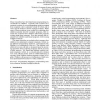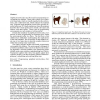16 search results - page 1 / 4 » Evaluation of Two Textual Programming Notations for Children |
AUIC
2005
IEEE
13 years 10 months ago
2005
IEEE
Many researchers have developed many programming environments for children. Typically each of these environments contains its own programming notation ranging from computer code t...
IWPC
2007
IEEE
13 years 11 months ago
2007
IEEE
Programs that use multi-threaded concurrency are known to be difficult to design. Moreover, research in computer-science education suggests that concurrency and synchronization co...
AUIC
2006
IEEE
13 years 10 months ago
2006
IEEE
Graphical rewrite rules are often used in programming environments for children. These rules consist of two parts: a left-hand side, which is visually matched in the environment, ...
ICML
2007
IEEE
14 years 5 months ago
2007
IEEE
In this paper, we define a family of syntactic kernels for automatic relational learning from pairs of natural language sentences. We provide an efficient computation of such mode...
PPOPP
2011
ACM
12 years 7 months ago
2011
ACM
We describe two novel constructs for programming parallel machines with multi-level memory hierarchies: call-up, which allows a child task to invoke computation on its parent, and...


